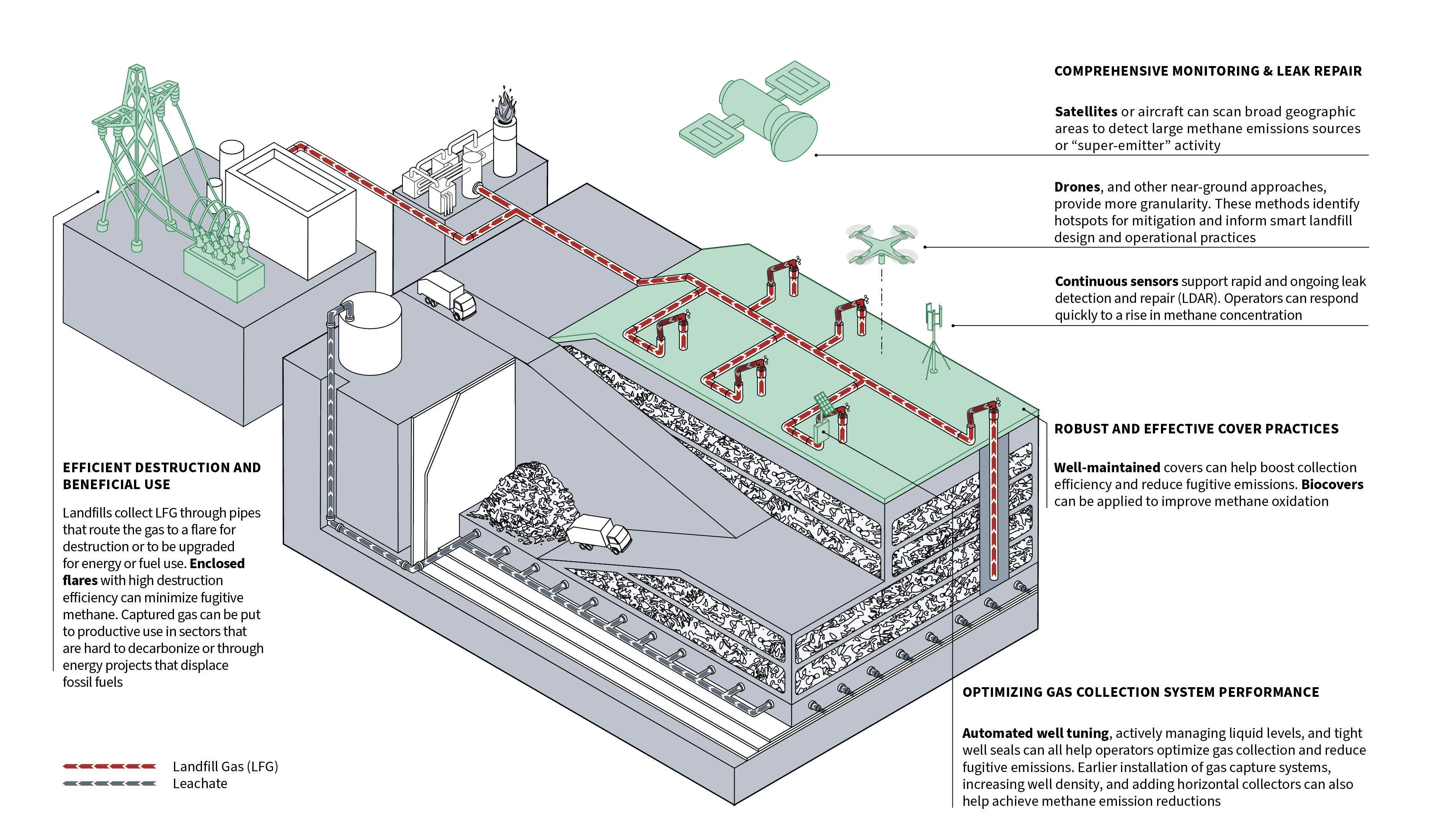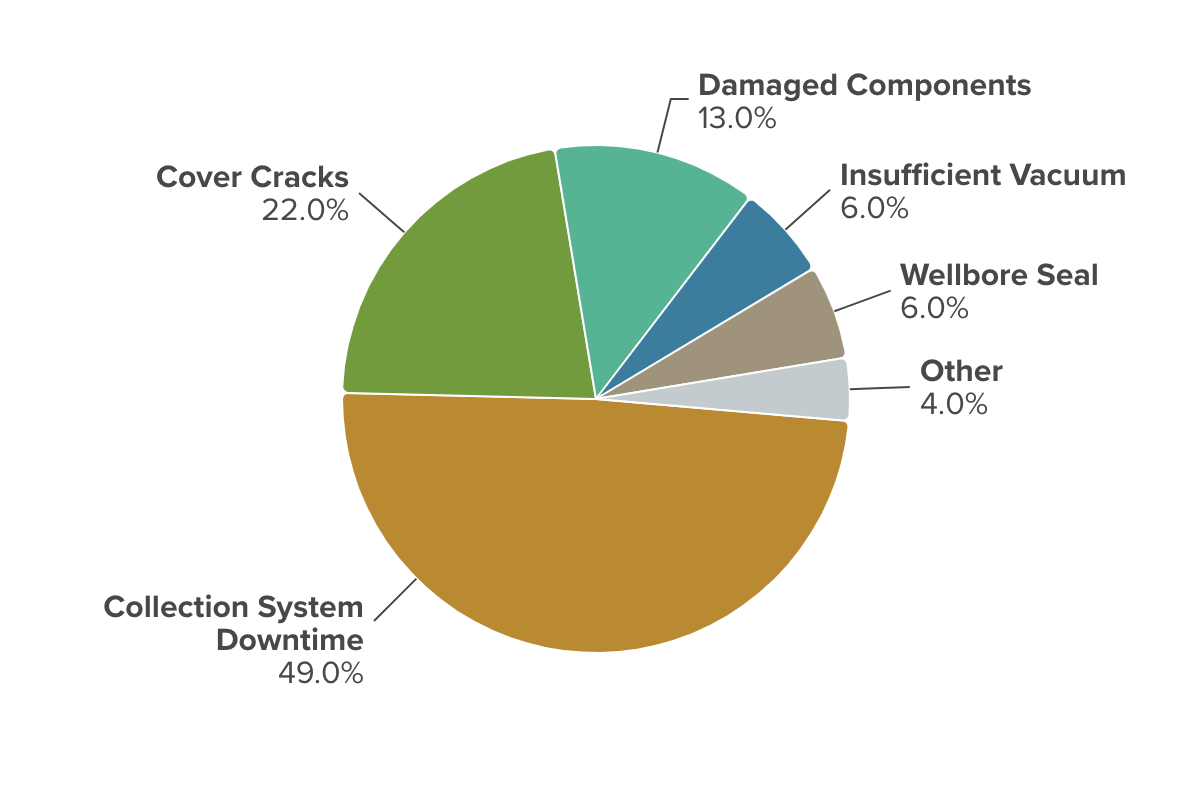Abichou, T. (2020). Using methane biological oxidation to partially finance sustainable waste management systems and closure of dumpsites in the Southern Mediterranean region. Euro-Mediterranean Journal for Environmental Integration. Link to source: https://doi.org/10.1007/s41207-020-00157-z
Auth, K., & Kincer, J. (2022). Untangling ‘stranded assets’ and ‘carbon lock-in.’ Energy for Growth Hub. Link to source: https://energyforgrowth.org/article/untangling-stranded-assets-and-carbon-lock-in/
Ayandele, E., Bodas, J., Gautam, S., & Velijala, V. (2024c). Sustainable organic waste management: A playbook for Lucknow, India. RMI. Link to source: https://www.teriin.org/policy-brief/sustainable-organic-waste-management-playbook-lucknow-india
Ayandele, E., Bodas, J., Krishnakumar, A., & Orakwe, L. (2024b). Mitigating methane emissions from municipal solid waste: A playbook for Lagos, Nigeria. RMI. Link to source: https://rmi.org/insight/waste-methaneassessment-platform/
Ayandele, E., Frankiewicz, T., & Garland, E. (2024a). Deploying advanced monitoring technologies at US landfills. RMI. Link to source: https://rmi.org/wp-content/uploads/dlm_uploads/2024/03/wasteMAP_united_states_playbook.pdf
Ayandele, E., Frankiewicz, T., & Wu, Y. (2024d). A playbook for municipal solid waste methane mitigation. RMI. Link to source: https://rmi.org/wp-content/uploads/dlm_uploads/2024/03/wastemap_global_strategy_playbook.pdf
Barton, D. (2020). Fourth five-year review report for Fresno municipal sanitary landfill superfund site Fresno county, California. U.S. Environmental Protection Agency. Link to source: https://semspub.epa.gov/work/09/100021516.pdf
Brender, J. D., Maantay, J. A., Chakraborty, J. (2011). Residential proximity to environmental hazards and adverse health outcomes. American Journal of Public Health, 101(S1). Link to source: https://pmc.ncbi.nlm.nih.gov/articles/PMC3222489/pdf/S37.pdf
Cai, B., Lou, Z., Wang, J., Geng, Y., Sarkis, J., Liu, J., & Gao, Q. (2018). CH4 mitigation potentials from China landfills and related environmental co-benefits. Science Advances, 4(7). Link to source: https://doi.org/10.1126/sciadv.aar8400
Carbon Mapper (2024, March 28). Study finds landfill point source emissions have an outsized impact and opportunity to tackle U.S. waste methane. Link to source: https://carbonmapper.org/articles/studyfinds-landfill
Casey, J. A., Cushing, L., Depsky, N., & Morello-Frosch, R. (2021). Climate justice and California's methane superemitters: Environmental equity assessment of community proximity and exposure intensity. Environmental Science & Technology, 55(21), 14746–14757. Link to source: https://doi.org/10.1021/acs.est.1c04328
City of Saskatoon. (2023). Landfill gas collection & power generation system. Retrieved September 2, 2024. Link to source: https://www.saskatoon.ca/services-residents/power-water-sewer/saskatoon-light-power/sustainable-electricity/landfill-gas-collection-power-generation-system
DeFabrizio, S., Glazener, W., Hart, C., Henderson, K., Kar, J., Katz, J., Pratt, M. P., Rogers, M., Ulanov, A., & Tryggestad, C. (2021). Curbing methane emissions: How five industries can counter a major climate threat. McKinsey Sustainability. Link to source: https://www.mckinsey.com/~/media/mckinsey/business%20functions/sustainability/our%20insights/curbing%20methane%20emissions%20how%20five%20industries%20can%20counter%20a%20major%20climate%20threat/curbing-methane-emissions-how-five-industries-can-counter-a-major-climate-threat-v4.pdf
Dobson, S., Goodday, V., & Winter, J. (2023). If it matters, measure it: A review of methane sources and mitigation policy in Canada. International Review of Environmental and Resource Economics, 16(3-4), 309–429. Link to source: https://doi.org/10.1561/101.00000146
Fries, J. (2020, March 26). Unique landfill gas solution found. Penticton Herald. Link to source: https://www.pentictonherald.ca/news/article_874b5c9c-6fb5-11ea-87ce-2b2aedf77300.html
Garland E., Alves O., Frankiewicz T., & Ayandele E. (2023). Mitigating landfill methane. RMI. Link to source: https://rmi.org/wp-content/uploads/dlm_uploads/2023/06/landfill_monitoring_memo_series.pdf
Global Climate & Health Alliance. (2024). Methane & health. Retrieved September 24, 2024. Link to source: https://climateandhealthalliance.org/initiatives/methane-health/
Global Methane Initiative. (2022). Policy maker’s handbook for measurement, reporting, and verification in the biogas sector. Link to source: https://www.globalmethane.org/resources/details.aspx?resourceid=5182
Global Methane Initiative (2024). 2023 accomplishments in methane mitigation, recovery, and use through U.S.-supported international efforts. Link to source: https://www.epa.gov/gmi/us-government-global-methane-initiative-accomplishments
Global Methane Pledge (2023). Lowering organic waste methane initiative (LOW-Methane). Retrieved March 6, 2025. Link to source: https://www.globalmethanepledge.org/news/lowering-organic-waste-methane-initiative-low-methane
Gómez-Sanabria, A., & Höglund-Isaksson, L. (2024). A comprehensive model for promoting effective decision-making and sustained climate change stabilization for South Africa. International Institute for Applied Systems Analysis. Link to source: https://pure.iiasa.ac.at/id/eprint/19897/1/Final_Report_SAFR.pdf
Government of Canada. (2024). Canada gazette, part I, volume 158, number 26: Regulations respecting the reduction in the release of methane (waste sector). Retrieved September 2, 2024. Link to source: https://canadagazette.gc.ca/rp-pr/p1/2024/2024-06-29/html/reg5-eng.html
Industrious Labs. (2024a). The hidden cost of landfills. Link to source: https://cdn.sanity.io/files/xdjws328/production/657706be7f29a20fe54692a03dbedce8809721e8.pdf
Industrious Labs. (2024b). Turning down the heat: How the U.S. EPA can fight climate change by cutting landfill emissions. Link to source: https://cdn.sanity.io/files/xdjws328/production/b562620948374268b8c6da61ec1c44960a8d5879.pdf
Intergovernmental Panel on Climate Change. (2023). Sixth assessment report (AR6). Link to source: https://www.ipcc.ch/assessment-report/ar6/
International Energy Agency. (2021). Global methane tracker 2021: Methane abatement and regulation. Link to source: https://www.iea.org/reports/methane-tracker-2021/methane-abatement-and-regulation
International Energy Agency. (2023). Net zero roadmap: A global pathway to keep the 1.5℃ goal in reach - 2023 update. Link to source: https://www.iea.org/reports/net-zero-roadmap-a-global-pathway-to-keep-the-15-0c-goal-in-reach
International Energy Agency. (2025). Methane tracker: Data tools. Link to source: https://www.iea.org/data-and-statistics/data-tools/methane-tracker
IPCC (2006). 2006 IPCC guidelines for national greenhouse gas inventories volume 5 waste. Link to source: https://www.ipcc-nggip.iges.or.jp/public/2006gl/vol5.html
Krause, M. Kenny, S., Stephensons, J. & Singleton, A (2023). Food waste management: Quantifying methane emissions from landfilled food waste. U.S. Environmental Protection Agency. Link to source: https://www.epa.gov/system/files/documents/2023-10/food-waste-landfill-methane-10-8-23-final_508-compliant.pdf
Malley, C. S., Borgford-Parnell, N. Haeussling, S., Howard, L. C., Lefèvre E. N., & Kuylenstierna J. C. I. (2023). A roadmap to achieve the global methane pledge. Environmental Research: Climate, 2(1). Link to source: https://doi.org/10.1088/2752-5295/acb4b4
Martin Charlton Communications. (2020). Features: Landfill biocovers. APEGS. Link to source: https://www.apegs.ca/features-landfill-biocovers
Martuzzi, M., Mitis, F., & Forastiere, F. (2010). Inequalities, inequities, environmental justice in waste management and health. European Journal of Public Health, 20(1), 21–26. Link to source: https://doi.org/10.1093/eurpub/ckp216
MethaneSAT. (n.d.). Solving a crucial climate challenge. Retrieved September 2, 2024. Link to source: https://www.methanesat.org/satellite/
Nesser, H., Jacob, D. J., Maasakkers, J. D., Lorente, A., Chen, Z., Lu, X., Shen, L., Qu, Z., Sulprizio, M. P., Winter, M., Ma, S., Bloom, A. A., Worden, J. R., Stavins, R. N., & Randles, C. A. . (2024). High-resolution US methane emissions inferred from an inversion of 2019 TROPOMI satellite data: Contributions from individual states, urban areas, and landfills. Atmospheric Chemistry and Physics, 24, 5069–5091. Link to source: https://doi.org/10.5194/acp-24-5069-2024
New York State Government. (2024). Important things to know about landfill gas. Retrieved September 3, 2024. Link to source: https://www.health.ny.gov/environmental/outdoors/air/landfill_gas.htm
Nisbet, E. G., Fisher, R. E., Lowry, D., France, J. L., Allen, G., Bakkaloglu, S., Broderick, T. J., Cain, M., Coleman, M., Fernandez, J., Forster, G., Griffiths, P. T., Iverach, C. P., Kelly, B. F. J., Manning, M. R., Nisbet-Jones, P. B. R., Pyle, J. A., Townsend-Small, A., al-Shalaan, A., Warwick, N., & Zazeri, G. (2020). Methane mitigation: Methods to reduce emissions,on the path to the Paris agreement. Review of Geophysics, 58(1). Link to source: https://doi.org/10.1029/2019RG000675
Ocko, I. B., Sun, T., Shindell, D., Oppenheimer, M. Hristov, A. N., Pacala, S. W., Mauzerall, D. L., Xu, Y. & Hamburg, S. P. (2021). Acting rapidly to deploy readily available methane mitigation measures by sector can immediately slow global warming. Environmental Research, 16(5). Link to source: https://doi.org/10.1088/1748-9326/abf9c8
Olaguer, E. P. (2021). The potential ozone impacts of landfills. Atmosphere, 12(7), 877. Link to source: https://doi.org/10.3390/atmos12070877
Plant, G., Kort, E. A., Brandt, A. R., Chen, Y., Fordice, G., Negron, A. M. G., Schwietzke, S., Smith, M., & Zavala-araiza, D. (2022). Estimates of solid waste disposal rates and reduction targets for landfill gas emissions. Science, 377(6614), 1566–1571. Link to source: https://doi.org/10.1126/science.abq0385
Powell J. T., Townsend, T. G., & Zimmerman, J. B. (2015). Estimates of solid waste disposal rates and reduction targets for landfill gas emissions. Nature Climate Change, 6, 162-165. Link to source: https://www.nature.com/articles/nclimate2804
Raniga, K., (2024). Waste Sector: Estimating CH4 Emissions from Solid Waste Disposal Sites [Data set]. WattTime, Climate TRACE Emissions Inventory. Retrieved April 21, 2025, from Link to source: https://climatetrace.org
SaveOnEnergy. (2024). Landfills: The truths about trash dumps by the numbers. Retrieved September 2, 2024, from Link to source: https://www.saveonenergy.com/resources/landfill-statistics/
Scarapelli, T. R., Cusworth, D. H., Duren, R. M., Kim, J., Heckler, J., Asner, G. P., Thoma, E., Krause, M. J., Heins, D., & Thorneloe, S. (2024). Investigating major sources of methane emissions at US landfills. Environmental Science & Technology. 58(29). Link to source: https://doi.org/10.1021/acs.est.4c07572
Scharff, H. Soon, H., Taremwa, S. R., Zegers, D., Dick, B., Zanon, T. V. B., & Shamrock, J. (2023). The impact of landfill management approaches on methane emissions. Waste Management & Research. Link to source: https://doi.org/10.1177/0734242X231200742
Scheutz, C., Pedersen, R. B., Petersen, P. H., Jørgensen, J. H. B., Ucendo, I. M. B., Mønster, J. G., Samuelsson, J., Kjeldsen, P. (2014). Mitigation of methane emission from an old unlined landfill in Klintholm, Denmark using a passive biocover system. Waste Management. 34(7), 1179–1190. Link to source: https://doi.org/10.1016/j.wasman.2014.03.015
Siddiqua, A., Hahladakis, J.N. & Al-Attiya, W.A.K.A. (2022). An overview of the environmental pollution and health effects associated with waste landfilling and open dumping. Environmental Science and Pollution Research 29, 58514–58536 Link to source: https://doi.org/10.1007/s11356-022-21578-z
Sperling Hansen Associates (2020). 7 Mile landfill operational biocover study. Link to source: https://www.rdmw.bc.ca/media/2020%2003%2017%207Mile%20Landfill%20Operational%20Biocover%20Study.pdf
Stern, J. C., Chanton, J., Ahicou, T., Powelson, D., Yuan, L., Escoriza, S. & Bogner, J.. (2007). Use of a biologically active cover to reduce landfill methane emissions and enhance methane oxidation. Waste Management 27(9), 1248–1258. Link to source: https://doi.org/10.1016/j.wasman.2006.07.018
Stone, E. (2023, September 7). Landfills: 'Zombie' landfills emit tons of methane decades after shutting down. Here's why that's a big problem. LAist. Link to source: https://laist.com/news/climate-environment/zombie-landfills-emit-tons-of-methane-decades-after-shutting-down-heres-why-thats-a-big-problem
Sweeptech. (2022). What is a landfill site’s environmental impact?. Retrieved March 7, 2025, from Link to source: https://www.sweeptech.co.uk/what-is-a-landfill-site-and-how-does-landfill-impact-the-environment/#:~:text=The%20average%20size%20of%20a,for%20these%20massive%20waste%20dumps.
Tangri, N. (2010). Respect for recyclers: Protecting the climate through zero waste. Gaia. Link to source: https://www.no-burn.org/wp-content/uploads/2021/11/Respect-for-Recyclers-English_1.pdf
Towprayoon, S., Ishigaki, T., Chiemchaisri, C., & Abdel-Aziz, A. O. (2019). Chapter 3: Solid waste disposal. In 2019 refinement to the 2006 IPCC guidelines for national greenhouse gas inventories. International Panel on Climate Change. Link to source: https://www.ipcc-nggip.iges.or.jp/public/2019rf/pdf/5_Volume5/19R_V5_3_Ch03_SWDS.pdf
Trashcans Unlimited. (2022). Biggest landfill in the world. Retrieved March 7, 2025. Link to source: https://trashcansunlimited.com/blog/biggest-landfill-in-the-world/
UN Environment Program. (2021). Global methane assessment: Benefits and costs of mitigating methane emissions. Link to source: https://www.unep.org/resources/report/global-methane-assessment-benefits-and-costs-mitigating-methane-emissions
U.S. Environmental Protection Agency. (2019). Global non-CO2 greenhouse gas emission projections & mitigation 2015–2050. Link to source: https://www.epa.gov/ozone-layer-protection/transitioning-low-gwp-alternatives-residential-and-commercial-air
U.S. Environmental Protection Agency. (2024a). Basic information about landfill gas. Retrieved September 2, 2024. Link to source: https://www.epa.gov/lmop/basic-information-about-landfill-gas
U.S. Environmental Protection Agency. (2024b). Benefits of landfill gas energy projects. Retrieved September 23, 2024. Link to source: https://www.epa.gov/lmop/benefits-landfill-gas-energy-projects
U.S. Environmental Protection Agency. (2025). Accomplishments of the landfill methane outreach program. Retrieved March 5, 2025. Link to source: https://www.epa.gov/lmop/accomplishments-landfill-methane-outreach-program
Van Dingenen, R., Crippa, M., Maenhout, G., Guizzardi, D., & Dentener, F. (2018). Global trends of methane emissions and their impacts on ozone concentrations. European Commission. Link to source: https://op.europa.eu/en/publication-detail/-/publication/c40e6fc4-dbf9-11e8-afb3-01aa75ed71a1/language-en
Vasarhelyi, K. (2021, April 15). The hidden damage of landfills. University of Colorado Boulder. Link to source: https://www.colorado.edu/ecenter/2021/04/15/hidden-damage-landfills#:~:text=The%20average%20landfill%20size%20is,liners%20tend%20to%20have%20leaks
Waste Today. (2019, June 26). How landfill covers can help improve operations. Retrieved April 13, 2025, from Link to source: https://www.wastetodaymagazine.com/news/interim-daily-landfill-covers/
Zhang, T. (2020, May 8). Landfill earth: A global perspective on the waste problem. Universitat de Barcelona. Link to source: https://diposit.ub.edu/dspace/bitstream/2445/170328/1/Landfill%20Eart.%20A%20Global%20Perspective%20on%20the%20Waste%20Problem.pdf




